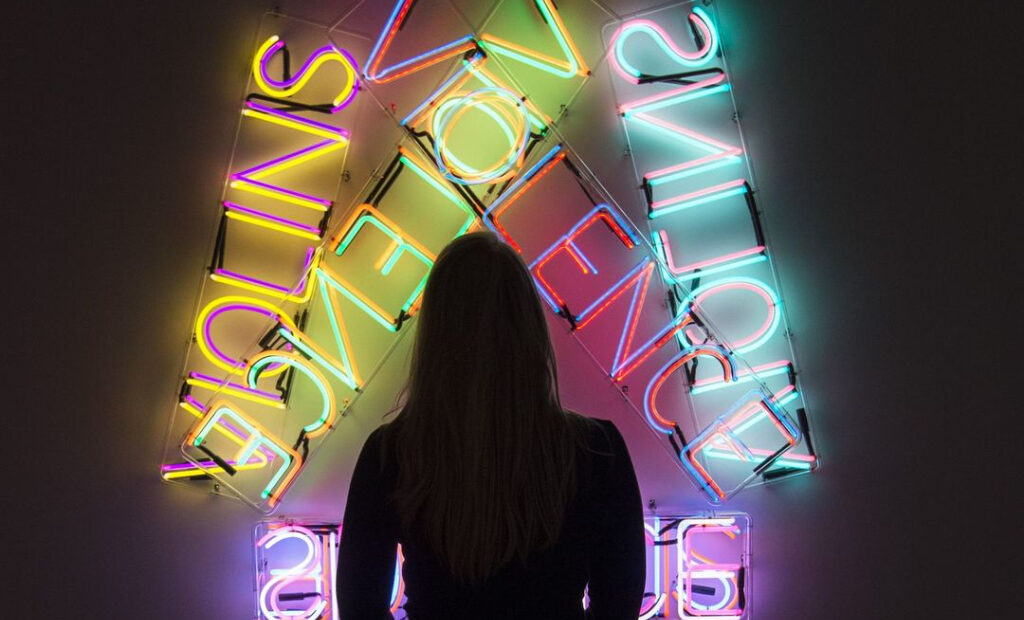Bruce Nauman

In the introductory text for Bruce Nauman at Tate Modern, the curators write that his work “is full of ideas”, before informing us that he has generally “refused to assign specific meanings to his artworks”. It’s quite a vague introduction to a multimedia creator who has been referred to by some as the world’s greatest living artist.
Despite the accolades, though, it is probable that Nauman is relatively unknown outside of the circles of art historians and cultural institutions. His work is certainly not the most appealing – adopting a spartan, low-budget aesthetic to convey deeply uncomfortable ideas. The only exceptions are his brightly glowing neon pieces, which provide moments of colourful relief punctuating an overarching palette of muted greys.
The show (which is not arranged in chronological order), opens with Nauman’s MAPPING THE STUDIO II (2001), filling the space with seven large video projections of the artist’s studios from different angles, filmed at night over a period of several weeks. In this tribute to experimental composer John Cage, nothing much happens. Occasionally, viewers will see a mouse (eyes glowing under the night-view camera’s gaze) or a moth fluttering up to obscure the lens. The film has its own strange beauty, and effectively introduces visitors to the subject’s concern with the artist’s studio and the role it plays in the creation of art.
Nauman’s early works from the late 1960s, shown in the second room, are significant examples of the development of 20th century art, in particular the emergence of what we now call conceptual art. Grainy black and white videos show the artist performing alone in his studio, bouncing against the corner of the room, walking in an exaggerated manner around a square, or holding a series of positions against the wall and floor. Walk with Contrapposto (1968) alludes to the typical pose of ancient Greek statuary, linking the subject’s ephemeral and playful experiments with a serious sculptural tradition.
However, the radical nature of these early understated pieces is not quite conveyed. Moreover, it’s difficult to concentrate on them because of the noisy, endless screaming emanating from another room, where Nauman’s Clown Torture (1987) is being shown on repeat. This issue of leaking sound reoccurs throughout the show, as the manic clown roars are replaced later with violin scrapings and the impressively performed but extremely grating yells of phrases like “Help me, hurt me, sociology” and “Feed me, eat me, anthropology” from the Anthro/Socio (Rinde Spinning) (1992). The cacophony of overlapping soundtracks is almost unbearable at points. While this might be a deliberate curatorial decision, it makes it almost impossible for the viewer to focus on the artwork.
The overwhelming background noise also diminishes a number of these works, which feel somewhat muted or even irrelevant: a caged passage created to the dimensions of Nauman’s body; a set of suspended metal girders; a group of black marble cubes in a yellow room. The curated space smacks slightly of the white-male-artist-as-self-proclaimed-genius syndrome that the art world claims to be trying to escape. A video of a female mime performing to the instructions of a harsh disembodied male voice works well as a counterpoint, but does it require a room larger than most people’s homes to display it? The video installation in the final room proves to be unwatchable – sleight-of-hand magic tricks slowed down to an unbearable degree.
There’s much of interest in Nauman’s long and ground-breaking career, and there are moments of real intrigue in this exhibition. However, it lacks a central narrative to energise it and the overwhelming noise levels threaten to set visitors’ teeth on edge.
Anna Souter
Featured Image: Violins, Violence, Silence, Bruce Nauman, c. 1981-2
© Photo: Bruce Nauman / Artists Rights Society (ARS), New York and DACS, London 2017
Bruce Nauman is at Tate Modern from 7th October until 21st October 2020. For further information visit the exhibition’s website here.
Watch the trailer for the exhibition here:

























Facebook
Twitter
Instagram
YouTube
RSS